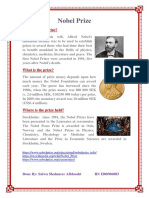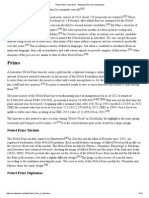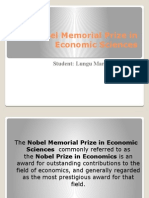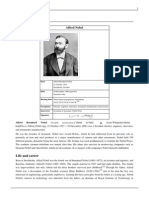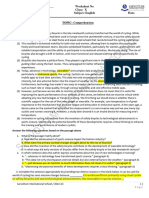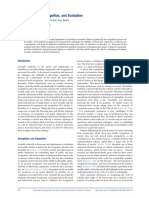Swedish Pronunciation
Swedish Pronunciation
Uploaded by
Naga SivaCopyright:
Available Formats
Swedish Pronunciation
Swedish Pronunciation
Uploaded by
Naga SivaOriginal Title
Copyright
Available Formats
Share this document
Did you find this document useful?
Is this content inappropriate?
Copyright:
Available Formats
Swedish Pronunciation
Swedish Pronunciation
Uploaded by
Naga SivaCopyright:
Available Formats
The Nobel Prize (Swedish pronunciation: [nobl], Swedish definite form, singular:Nobelpriset; Norwegian: Nobelprisen) is a set of annual international
awards bestowed in a number of categories by Scandinavian committees in recognition of cultural and/or scientific advances. The will of the Swedish philanthropist inventorAlfred Nobel established the prizes in 1895. The prizes [1] in Physics, Chemistry,Physiology or Medicine, Literature, and Peace were first awarded in 1901. The Peace Prize is awarded in Oslo, Norway, while the other prizes are awarded inStockholm, Sweden. The Nobel Prize is widely regarded as the most prestigious award available in the fields of literature, [2] medicine, physics, chemistry, peace, and economics. The Royal Swedish Academy of Sciences awards the Nobel Prize in Physics, the Nobel Prize in Chemistry, and the Nobel Memorial Prize in Economic Sciences; the Nobel Assembly at Karolinska Institutet awards the Nobel Prize in Physiology or Medicine; the Swedish Academy grants the Nobel Prize in Literature; and the Nobel Peace Prize is not awarded by a Swedish organisation but by the Norwegian Nobel Committee. Each recipient, or laureate, receives a gold medal, a diploma and a sum of money, which is decided by the Nobel Foundation, yearly. As of 2012, each prize was worth 8 million SEK (c. US$1.2 million, 0.93 million). The prize is not awarded posthumously; however, if a person is awarded a prize and dies before [3] receiving it, the prize may still be presented. Though the average number of laureates per prize increased substantially during the 20th century, a prize may not be shared among more than three [4] people.
Contents
[hide]
1 History
o o o o
1.1 Nobel Foundation 1.2 First prizes 1.3 World War II 1.4 Prize in Economic Sciences
2 Award process
o o o o
2.1 Nominations 2.2 Selection 2.3 Posthumous nominations 2.4 Recognition time lag
3 Award ceremonies
o o
3.1 Nobel banquet 3.2 Nobel lecture
4 Prizes
o o o
4.1 Medals 4.2 Diplomas 4.3 Award money
5 Controversies and criticisms
o o o
5.1 Controversial recipients 5.2 Overlooked achievements 5.3 Emphasis on discoveries over inventions
6 Specially distinguished laureates
o o
6.1 Multiple laureates 6.2 Family laureates
7 Refusals and constraints 8 See also 9 References
o o
9.1 Notes 9.2 Bibliography
10 External links
[edit]History
Alfred Nobel had the unpleasant surprise of reading his own obituary, titled The merchant of death is dead, in a French newspaper.
Alfred Nobel ( listen (helpinfo)) was born on 21 October 1833 in Stockholm, Sweden, into a family of [5] engineers. He was a chemist, engineer, and inventor. In 1894, Nobel purchased the Bofors iron and steel mill, which he made into a major armaments manufacturer. Nobel also invented ballistite, a precursor to many smokeless military explosives, especially the British smokeless powder cordite. Nobel
was even involved in a patent infringement lawsuit over cordite. Nobel amassed a fortune during his [6] lifetime, with most of his wealth from his 355 inventions, of which dynamite is the most famous. In 1888, Nobel was astonished to read his own obituary, titled The merchant of death is dead, in a French newspaper. As it was Alfred's brother Ludvig who had died, the obituary was eight years premature. The article disconcerted Nobel and made him apprehensive about how he would be remembered. This [7] inspired him to change his will. On 10 December 1896, Alfred Nobel died in his villa in San Remo, Italy, [8] from a cerebral haemorrhage. He was 63 years old. Nobel wrote several wills during his lifetime. The last was written over a year before he died, signed at the [9][10] SwedishNorwegian Club in Paris on 27 November 1895. To widespread astonishment, Nobel's last will specified that his fortune be used to create a series of prizes for those who confer the "greatest [11] benefit on mankind" in physics, chemistry, peace,physiology or medicine, and literature. Nobel bequeathed 94% of his total assets, 31 million SEK (c. US$186 million, 150 million in 2008), to establish [12] the five Nobel Prizes. Because of scepticism surrounding the will, it was not until 26 April 1897 that it [13] was approved by the Storting in Norway. The executors of Nobel's will, Ragnar Sohlman and Rudolf Lilljequist, formed the Nobel Foundation to take care of Nobel's fortune and organise the award of [14] prizes. Nobel's instructions named a Norwegian Nobel Committee to award the Peace Prize, the members of whom were appointed shortly after the will was approved in April 1897. Soon thereafter, the other prizeawarding organisations were designated or established. These were the Karolinska Institutet on 7 June, [15] the Swedish Academy on 9 June, and the Royal Swedish Academy of Sciences on 11 June. The Nobel Foundation reached an agreement on guidelines for how the prizes should be awarded; and, in 1900, the [11] Nobel Foundation's newly created statutes were promulgated by King Oscar II. In 1905, the personal union between Sweden and Norway was dissolved. Thereafter, Norway's Nobel Committee was responsible for awarding the Nobel Peace Prize and the Swedish institutions retained responsibility for [13] the other prizes. [edit]Nobel
Foundation
Main article: Nobel Foundation
Alfred Nobel's will stated that 94% of his total assets should be used to establish the Nobel Prizes.
The Nobel Foundation was founded as a private organisation on 29 June 1900, to manage the finances [16] and administration of the Nobel Prizes. In accordance with Nobel's will, the primary task of the Foundation is to manage the fortune Nobel left.Robert and Ludwig Nobel were involved in the oil business in Azerbaijan and, according to Swedish historian E. Bargengren, who accessed the Nobel family
archives, it was this "decision to allow withdrawal of Alfred's money from Baku that became the decisive [17] factor that enabled the Nobel Prizes to be established". Another important task of the Nobel Foundation is to market the prizes internationally and to oversee informal administration related to the prizes. The [18][19] Foundation is not involved in the process of selecting the Nobel laureates. In many ways, the Nobel Foundation is similar to an investment company, in that it invests Nobel's money to create a solid funding base for the prizes and the administrative activities. The Nobel Foundation is exempt from all taxes in [20] Sweden (since 1946) and from investment taxes in the United States (since 1953). Since the 1980s, the Foundation's investments have become more profitable and as of 31 December 2007, the assets [21] controlled by the Nobel Foundation amounted to 3.628 billion Swedish kronor(c. US$560 million).
Mother Teresa, Peace prize recipient
According to the statutes, the Foundation consists of a board of five Swedish or Norwegian citizens, with its seat in Stockholm. The Chairman of the Board is appointed by the Swedish King in Council, with the other four members appointed by the trusteesof the prize-awarding institutions. An Executive Director is chosen from among the board members, a Deputy Director is appointed by the King in Council, and two deputies are appointed by the trustees. However, since 1995, all the members of the board have been chosen by the trustees, and the Executive Director and the Deputy Director appointed by the board itself. As well as the board, the Nobel Foundation is made up of the prize-awarding institutions (the Royal Swedish Academy of Sciences, the Nobel Assembly at Karolinska Institute, the Swedish Academy, and [21] the Norwegian Nobel Committee), the trustees of these institutions, and auditors. [edit]First
prizes
Wilhelm Conrad Rntgenreceived the first Physics Prize for his discovery of X-rays.
Once the Nobel Foundation and its guidelines were in place, the Nobel Committeesbegan collecting nominations for the inaugural prizes. Subsequently they sent a list of preliminary candidates to the prizeawarding institutions. Originally, the Norwegian Nobel Committee appointed prominent figures including Jrgen Lvland, Bjrnstjerne Bjrnson andJohannes Steen to give the Nobel Peace Prize [22] credibility. The committee awarded the Peace Prize to two prominent figures in the growing peace movement around the end of the 19th century. These were Frdric Passy, co-founder of the InterParliamentary Union, andHenry Dunant the founder of the International Committee of the Red [23][24][25] Cross. The Nobel Committee's Physics Prize shortlist cited Wilhelm Conrad Rntgen's discovery ofXrays and Philipp Lenard's work on cathode rays. The Academy of Sciences selected Rntgen for the [26][27] prize. In the last decades of the 19th century, many chemists had made significant contributions. Thus, with the Chemistry Prize, the Academy "was chiefly faced with merely deciding the order in which [28] these scientists should be awarded the prize." The Academy received 20 nominations, eleven of them [29] for Jacobus van't Hoff. Van't Hoff was awarded the prize for his contributions in chemical [30][31] thermodynamics. The Swedish Academy chose the poet Sully Prudhomme for the first Nobel Prize in Literature. A group including 42 Swedish writers, artists and literary critics protested against this decision, having [32] expected Leo Tolstoy to win. Some, including Burton Feldman, have criticised this prize because they consider Prudhomme a mediocre poet. Feldman's explanation is that most of the Academy members [33] preferred Victorian literature and thus selected a Victorian poet. The first Physiology or Medicine Prize went to the German physiologist and microbiologist Emil von Behring. During the 1890s, von Behring developed an antitoxin to treat diphtheria, which until then was causing thousands of deaths each [34][35] year. [edit]World
War II
In 1938 and 1939, Adolf Hitler's Third Reich forbade three laureates from Germany (Richard Kuhn, Adolf [36] Friedrich Johann Butenandt, and Gerhard Domagk) from accepting their prizes. Each man was later
able to receive the diploma and medal. Even though Sweden was officially neutral during World War II, the prizes were awarded irregularly. In 1939, the Peace Prize was not awarded. No prize was awarded in any category from 194042, due to the occupation of Norway by Germany. In the subsequent year, all [38] prizes were awarded except those for literature and peace. During the occupation of Norway, three members of the Norwegian Nobel Committee fled into exile. The remaining members escaped persecution from the Nazis when the Nobel Foundation stated that the Committee building in Oslo was Swedish property. Thus it was a safe haven from the German military, [39] which was not at war with Sweden. These members kept the work of the Committee going but did not award any prizes. In 1944 the Nobel Foundation, together with the three members in exile, made sure [36] that nominations were submitted for the Peace Prize and that the prize could be awarded once again.
[37]
Map of Nobel laureates by country.
[edit]Prize
in Economic Sciences
Main article: Nobel Memorial Prize in Economic Sciences In 1968, Sveriges Riksbank celebrated its 300th anniversary by donating a large sum of money to the Nobel Foundation to be used to set up a prize in honor of Nobel. The following year, the Nobel Memorial Prize in Economic Sciences was awarded for the first time. The Royal Swedish Academy of Sciences became responsible for selecting laureates. The first laureates for the Economics Prize were Jan Tinbergen and Ragnar Frisch "for having developed and applied dynamic models for the analysis of [40][41] economic processes." Although not a Nobel Prize, it is intimately identified with the other awards; the laureates are announced with the Nobel Prize recipients, and the Prize in Economic Sciences is [42] presented at the Swedish Nobel Prize Award Ceremony. The Board of the Nobel Foundation decided [43] that after this addition, it would allow no further new prizes. [edit]Award
process
The award process is similar for all of the Nobel Prizes; the main difference is in who can make [44] nominations for each of them.
The announcement of the laureates in Nobel Prize in Chemistry 2009 byGunnar quist, permanent secretary of the Royal Swedish Academy of Sciences
2009 Nobel Prize in Literature announcement by Peter Englund in Swedish, English and German
[edit]Nominations Nomination forms are sent by the Nobel Committee to about 3000 individuals, usually in September the year before the prizes are awarded. These individuals are often academics working in a relevant area. For the Peace Prize, inquiries are sent to governments, members of international courts, professors and rectors, former Peace Prize laureates and current or former members of the Norwegian Nobel Committee. [44][45] The deadline for the return of the nomination forms is 31 January of the year of the award. The [46] Nobel Committee nominates about 300 potential laureates from these forms and additional names. The nominees are not publicly named, nor are they told that they are being considered for the prize. All [47][48] nomination records for a prize are sealed for 50 years from the awarding of the prize. [edit]Selection The Nobel Committee then prepares a report reflecting the advice of experts in the relevant fields. This, [49] along with the list of preliminary candidates, is submitted to the prize-awarding institutions. The institutions meet to choose the laureate or laureates in each field by a majority vote. Their decision, which [50] cannot be appealed, is announced immediately after the vote. A maximum of three laureates and two different works may be selected per award. Except for the Peace Prize, which can be awarded to [51] institutions, the awards can only be given to individuals. If the Peace Prize is not awarded, the money [52] is split among the scientific prizes. This has happened 19 times so far. [edit]Posthumous
nominations
Although posthumous nominations are not permitted, individuals who die in the months between their nomination and the decision of the prize committee were originally eligible to receive the prize. This has occurred twice: the 1931 Literature Prize awarded to Erik Axel Karlfeldt, and the 1961 Peace Prize awarded to UN Secretary General Dag Hammarskjld. Since 1974, laureates must be thought alive at the time of the October announcement. There has been one laureate, William Vickrey, who in 1996 died after [53] the prize (in Economics) was announced but before it could be presented. On 3 October 2011, the laureates for the Nobel Prize in Physiology or Medicine were announced; however, the committee was not aware that one of the laureates,Ralph M. Steinman, had died three days earlier. The committee was [3] debating about Steinman's prize, since the rule is that the prize is not awarded posthumously. The committee later decided that as the decision to award Steinman the prize "was made in good faith," it [54] would remain unchanged. [edit]Recognition
time lag
Nobel's will provides for prizes to be awarded in recognition of discoveries made "during the preceding [55] year". Early on, the awards usually recognised recent discoveries. However, some of these early discoveries were later discredited. For example,Johannes Fibiger was awarded the 1926 Prize [56] for Physiology or Medicine for his purported discovery of a parasite that caused cancer. To avoid this embarrassment, the awards increasingly recognised scientific discoveries that had withstood the test of [57][58][59] time. According to Ralf Pettersson, former chairman of the Nobel Prize Committee for Physiology or Medicine, "the criterion the previous year is interpreted by the Nobel Assembly as the year when the [58] full impact of the discovery has become evident."
The committee room of the Norwegian Nobel Committee
The interval between the award and the accomplishment it recognises varies from discipline to discipline. The Literature Prize is typically awarded to recognise a cumulative lifetime body of work rather than a [60][61] single achievement. The Peace Prize can also be awarded for a lifetime body of work. For example [62][63] 2008 laureate Martti Ahtisaari was awarded for his work to resolve international conflicts. However, [64] they can also be awarded for specific recent events. For instance, Kofi Annan was awarded the 2001 Peace Prize just four years after becoming the Secretary-General of the United [65] Nations. Similarly Yasser Arafat, Yitzhak Rabin, and Shimon Peres received the 1994 award, about a [66] year after they successfully concluded the Oslo Accords. Although Nobel's will stated that prizes should be awarded for contributions made "during the preceding year", awards for physics, chemistry, and medicine are typically awarded once the achievement has been widely accepted. Sometimes, this takes decades for example,Subrahmanyan Chandrasekhar shared [67][68] the 1983 Physics Prize for his 1930s work on stellar structure and evolution. Not all scientists live long enough for their work to be recognised. Some discoveries can never be considered for a prize if their [69][70][71] impact is realised after the discoverers have died. [edit]Award
ceremonies
Left: Barack Obama after receiving the Nobel Peace Prize in Oslo City Hall from the hands of Norwegian Nobel Committee Chairman Thorbjorn Jagland; Right: Giovanni Jona-Lasinio presenting Yoichiro Nambu's Nobel Lecture at Aula Magna, Stockholm in 2008
Except for the Peace Prize, the Nobel Prizes are presented in Stockholm, Sweden, at the annual Prize Award Ceremony on 10 December, the anniversary of Nobel's death. The recipients' lectures are normally held in the days prior to the award ceremony. The Peace Prize and its recipients' lectures are presented at the annual Prize Award Ceremony in Oslo, Norway, usually on 10 December. The award [72][73] ceremonies and the associated banquets are typically major international events. The Prizes awarded in Sweden's ceremonies' are held at the Stockholm Concert Hall, with the Nobel banquet following immediately at Stockholm City Hall. The Nobel Peace Prize ceremony has been held at the Norwegian Nobel Institute (19051946), at theauditorium of the University of Oslo (19471989) and [74] at Oslo City Hall(1990present). The highlight of the Nobel Prize Award Ceremony in Stockholm occurs when each Nobel Laureate steps forward to receive the prize from the hands of the King of Sweden. In Oslo, the Chairman of the Norwegian Nobel Committee presents the Nobel Peace Prize in the presence of the King of [73][75] Norway. At first King Oscar II did not approve of awarding grand prizes to foreigners. It is said that [76] his mind changed once his attention had been drawn to the publicity value of the prizes for Sweden. [edit]Nobel
banquet
Table at the 2005 Nobel Banquet in Stockholm
After the award ceremony in Sweden, a banquet is held at the Stockholm City Hall, which is attended by the Swedish Royal Family and around 1,300 guests. The banquet features a three-course dinner, entertainment, and dancing, and is covered extensively by Swedish media. The Nobel Peace Prize banquet is held in Oslo at the Grand Hotel after the award ceremony. Apart from the laureate, guests include the President of the Storting, the Prime Minister, and, since 2006, the King and Queen of Norway.
In total, about 250 guests attend for a five-course meal. All aspects of the Nobel Banquet are carefully thought through including the experience from and round the meal. The colour and lighting of the banquet venue and the ambience it creates, the music being played, the acoustic of the venue, the design of the [78] cutlery, furniture and glass are all taken into serious consideration. For the first time in its history, the banquet was cancelled in Oslo in 1979 because the laureate, Mother Teresa, refused to attend, saying the money would be better spent on the poor. Mother Teresa used the US$7,000 that was to be spent on the banquet to hold a dinner for 2,000 homeless people on Christmas [79][80] Day. [edit]Nobel
[77]
lecture
According to the statutes of the Nobel Foundation, each laureate is required to give a public lecture on a [81][82] subject related to the topic of their prize. The Nobel lecture as a rhetorical genre took decades to [83] reach its current format. These lectures normally occur during Nobel Week (the week leading up to the award ceremony and banquet, which begins with the laureates arriving in Stockholm and normally ends with the Nobel banquet), but this is not mandatory. The laureate is only obliged to give the lecture within six months of receiving the prize. Some have happened even later. For example, US president Theodore [84] Roosevelt won the Peace Prize in 1906 but gave his lecture in 1910, after his term in office. The [85] lectures are organized by the same association which selected the laureates. [edit]Prizes [edit]Medals It was announced on 30 May 2012 that the Nobel Foundation had awarded the contract for the production of the five (Swedish) Nobel Prize medals to Svenska Medalj AB. Formerly, the Nobel Prize medals were minted by Myntverket (the Swedish Mint) in between 1902-2010. Myntverket, Sweden's oldest company, ceased operations in 2011 after 1017 years. In 2011 the Mint of Norway, located in Kongsberg, made the [86] medals. The Nobel Prize medals are registered trademarks of the Nobel Foundation. Each medal features an image of Alfred Nobel in left profile on the obverse. The medals for physics, chemistry, physiology or medicine, and literature have identical obverses, showing the image of Alfred Nobel and the years of his birth and death. Nobel's portrait also appears on the obverse of the Peace Prize medal and the medal for the Economics Prize, but with a slightly different design. For instance, the laureate's name [87] is engraved on the rim of the Economics medal. The image on the reverse of a medal varies according to the institution awarding the prize. The reverse sides of the medals for chemistry and physics share the [88] same design.
Laureates receive a heavily decorated diploma together with a gold medal and the prize money. Here Fritz Haber's diploma is shown, which he received for the development of a method to synthesise ammonia.
All medals made before 1980 were struck in 23 carat gold. Since then they have been struck in 18 carat green gold plated with 24 carat gold. The weight of each medal varies with the value of gold, but averages about 175 grams (0.39 lb) for each medal. The diameter is 66 millimetres (2.6 in) and the [89] thickness varies between 5.2 millimetres (0.20 in) and 2.4 millimetres (0.094 in). Because of the high value of their gold content and tendency to be on public display, Nobel medals are subject to medal [90][91][92] theft. During World War II, the medals of German scientists Max von Laue and James Franck were sent to Copenhagen for safekeeping. When Germany invaded Denmark, chemist George de Hevesy dissolved them in aqua regia, to prevent confiscation by Nazi Germany and to prevent legal [93] problems for the holders. After the war, the gold was recovered from solution, and the medals re-cast. [edit]Diplomas Nobel laureates receive a diploma directly from the hands of the King of Sweden or the Chairman of the Norwegian Nobel Committee. Each diploma is uniquely designed by the prize-awarding institutions for the [94] laureates that receive them. The diploma contains a picture and text which states the name of the laureate and normally a citation of why they received the prize. None of the Nobel Peace Prize laureates [95][96] has ever had a citation on their diplomas. [edit]Award
money
The laureates are given a sum of money when they receive their prizes, in the form of a document [87] confirming the amount awarded. The amount of prize money depends upon how much money the Nobel Foundation can award each year. The purse has increased since the 1980s, when the prize money was 880 000 SEK (c. 2.6 million SEK, US$350 000 or 295,000 today) per prize. In 2009, the monetary [97][98] award was 10 million SEK (US$1.4 million, 950,000). In June 2012, it was lowered to 8 million [99] SEK. If there are two laureates in a particular category, the award grant is divided equally between the recipients. If there are three, the awarding committee has the option of dividing the grant equally, or [100][101][102] awarding one-half to one recipient and one-quarter to each of the others. It is not uncommon for [103][104] recipients to donate prize money to benefit scientific, cultural, or humanitarian causes.
document
You might also like
- Tugas Unjuk Keterampilan-AlfiDocument46 pagesTugas Unjuk Keterampilan-Alfimiftakhulhuda0823100% (1)
- Atestat EnglezaDocument8 pagesAtestat EnglezaAnca Şi AdiNo ratings yet
- Background of Nobel FoundationDocument2 pagesBackground of Nobel Foundationcoolrsk17No ratings yet
- Nobel Prize in ChemistryDocument5 pagesNobel Prize in ChemistryGmanXXZZNo ratings yet
- Alfred Nobel Physics Chemistry Physiology Medicine Literature Paris Swedish Kronor US Storting Ragnar SohlmanDocument1 pageAlfred Nobel Physics Chemistry Physiology Medicine Literature Paris Swedish Kronor US Storting Ragnar Sohlmanmanish.cdmaNo ratings yet
- Nobel Prize in Physics - WikipediaDocument7 pagesNobel Prize in Physics - WikipediamomojiNo ratings yet
- Final Envs Vu Dang Khoi 22055633Document21 pagesFinal Envs Vu Dang Khoi 22055633Khoi DangNo ratings yet
- Encyclopedia of Nobel Laureates in Economic SciencesDocument122 pagesEncyclopedia of Nobel Laureates in Economic Sciencessimongold205No ratings yet
- 10-The Nobel PrizeDocument4 pages10-The Nobel PrizeAndrés Osorio ValenciaNo ratings yet
- Nobel Prize: From Wikipedia, The Free EncyclopediaDocument1 pageNobel Prize: From Wikipedia, The Free EncyclopediazidaaanNo ratings yet
- PrizeDocument9 pagesPrizeLavKaushikNo ratings yet
- Nobel PrizeDocument2 pagesNobel PrizeArun GopinathNo ratings yet
- Noble Persons of India PDFDocument1 pageNoble Persons of India PDFayanbar0010No ratings yet
- Language Centre of The National University of Santa: "Year of Production Diversification and Strengthening Education"Document12 pagesLanguage Centre of The National University of Santa: "Year of Production Diversification and Strengthening Education"Gianella Angelica Capillo MinayaNo ratings yet
- Nobel Prize in Literature: Nobelpriset I Litteratur) Has Been Awarded Annually To AnDocument2 pagesNobel Prize in Literature: Nobelpriset I Litteratur) Has Been Awarded Annually To AnMichael EvansNo ratings yet
- NobelDocument4 pagesNobelduchien170978No ratings yet
- A Mistaken Obituary Gave Alfred Nobel The Idea For The PrizesDocument3 pagesA Mistaken Obituary Gave Alfred Nobel The Idea For The Prizesmaddy mNo ratings yet
- List of Nobel LaureatesDocument165 pagesList of Nobel LaureatesSamrat PvNo ratings yet
- History of The Nobel PrizeDocument7 pagesHistory of The Nobel PrizeChristina Neikhrie PairaNo ratings yet
- Physicist Chemist Radioactivity Multiple Sciences University of Paris PanthéonDocument2 pagesPhysicist Chemist Radioactivity Multiple Sciences University of Paris PanthéonAdam YoungNo ratings yet
- Awards and Honours International: Nobel PrizeDocument6 pagesAwards and Honours International: Nobel PrizetikshathNo ratings yet
- Data Sufficieny QuestionsDocument2 pagesData Sufficieny Questionslovelyosmile253No ratings yet
- Nobel Prize in LiteratureDocument20 pagesNobel Prize in LiteraturefigbhrdevdqtelfcceNo ratings yet
- MONTESSORIDocument2 pagesMONTESSORIJariya SandiganNo ratings yet
- Facts: There Is No Nobel Prize For MathematicsDocument1 pageFacts: There Is No Nobel Prize For Mathematicstusharsinghvi1No ratings yet
- Presentation1 1518359856592Document15 pagesPresentation1 1518359856592Vivek SharmaNo ratings yet
- Nobel PrizeDocument4 pagesNobel Prizeapi-401626338No ratings yet
- NobelPrizeLessons 2018 AlfredNobel Speakers Manuscript-2Document6 pagesNobelPrizeLessons 2018 AlfredNobel Speakers Manuscript-2caizunqiNo ratings yet
- Nobel Prize DocumnetDocument4 pagesNobel Prize DocumnetNithin C VNo ratings yet
- Nobel Prize of Literature InvestigationDocument14 pagesNobel Prize of Literature InvestigationanaNo ratings yet
- Teachers Manuscript - Alfred Nobel and The Nobel PrizeDocument5 pagesTeachers Manuscript - Alfred Nobel and The Nobel PrizeMauz KhanNo ratings yet
- The Nobel PrizeDocument26 pagesThe Nobel Prizeannoyedking90No ratings yet
- Nobel PrizeDocument1 pageNobel PrizeAnna KhachatryanNo ratings yet
- STS Activity 2Document3 pagesSTS Activity 2Gwen De GuzmanNo ratings yet
- Aspire Jan14Document16 pagesAspire Jan14jeroldscdNo ratings yet
- Screenshot 2020-11-02 at 11.04.46 PMDocument1 pageScreenshot 2020-11-02 at 11.04.46 PMsumaya.lifeNo ratings yet
- Nobel PrizesDocument8 pagesNobel Prizesmsjl1234567890No ratings yet
- Nobel PrizesDocument25 pagesNobel PrizesEdgar ManríquezNo ratings yet
- Nobel 2Document1 pageNobel 2api-382084216No ratings yet
- NobelDocument1 pageNobelapi-382172511No ratings yet
- MaryamDocument1 pageMaryamapi-401610684No ratings yet
- Presentation 6Document5 pagesPresentation 6api-380600966No ratings yet
- Alfred Nobel and His Prizes From Dynamite To DNADocument15 pagesAlfred Nobel and His Prizes From Dynamite To DNAMauricio García CamachoNo ratings yet
- Nobel Prize Facts PDFDocument9 pagesNobel Prize Facts PDFGovinda SahaNo ratings yet
- Alfred Nobel. 2Document3 pagesAlfred Nobel. 2Just AnotherNo ratings yet
- Awards In: Engineering Physics and Related FieldsDocument7 pagesAwards In: Engineering Physics and Related FieldsDivyansh RajatNo ratings yet
- Nobel Prize 2009 and All LaureatesDocument3 pagesNobel Prize 2009 and All Laureateschauhanaimt38No ratings yet
- About Nobel PrizeDocument2 pagesAbout Nobel PrizesaidaNo ratings yet
- Nobel PrizeDocument1 pageNobel Prizeapi-397929102No ratings yet
- Abel Prize: Selection CriteriaDocument4 pagesAbel Prize: Selection Criteriacharles luisNo ratings yet
- Prizes: Nobel Prize MedalsDocument2 pagesPrizes: Nobel Prize MedalsMichael EvansNo ratings yet
- (English) How To Win A Nobel Prize (DownSub - Com)Document4 pages(English) How To Win A Nobel Prize (DownSub - Com)Thanh Huyền PhùngNo ratings yet
- Nobel Memorial Prize in Economic SciencesDocument14 pagesNobel Memorial Prize in Economic SciencesPasluNo ratings yet
- English Grade 8 - Reading Test 01Document4 pagesEnglish Grade 8 - Reading Test 01Al haqNo ratings yet
- Bài tập supplementary exercise 4 -UNIT 4 Phải làmDocument3 pagesBài tập supplementary exercise 4 -UNIT 4 Phải làmNhat LeNo ratings yet
- Alfred NobelDocument7 pagesAlfred NobelvergaaaNo ratings yet
- GK Noble PrizeDocument53 pagesGK Noble PrizeANUJ ANANTWADNo ratings yet
- Alfred Nobel 4Document4 pagesAlfred Nobel 4freefromfakesNo ratings yet
- Description:: B: Great, in Conclusion, Alfred Nobel Was An Intelligent PersonDocument1 pageDescription:: B: Great, in Conclusion, Alfred Nobel Was An Intelligent PersonAndersonGabriel23No ratings yet
- NOBEL Prize ResearchDocument12 pagesNOBEL Prize ResearchUpanisha100% (1)
- Nobel Prize Winners 2023 ListDocument11 pagesNobel Prize Winners 2023 Listbahnijitmongal1234No ratings yet
- 5070 Manthan2.0JANUARY-2024 WEEK-1 (Topic1-10) V05012024Document34 pages5070 Manthan2.0JANUARY-2024 WEEK-1 (Topic1-10) V05012024Vanshika GaurNo ratings yet
- Gunnar MyrdalDocument16 pagesGunnar MyrdaldeviNo ratings yet
- SSE-Doctor of Philosophy ProgramsDocument18 pagesSSE-Doctor of Philosophy ProgramsSelvingSabillonNo ratings yet
- Last 6 Month Current Affair)Document28 pagesLast 6 Month Current Affair)Jayraj SharmaNo ratings yet
- ComprehensionsDocument11 pagesComprehensionssushanta121808No ratings yet
- Nobel Prize Facts PDFDocument9 pagesNobel Prize Facts PDFGovinda SahaNo ratings yet
- Reading Assignment For Week 3Document3 pagesReading Assignment For Week 3Ivana PetrovićNo ratings yet
- More Foreigners Earning PhDs in Sweden - The LocalDocument38 pagesMore Foreigners Earning PhDs in Sweden - The LocalOMSURYACHANDRASIVANo ratings yet
- Awards, Public Recognition, and Evaluation: Rafael Yann Scho Gler, University of Graz, Graz, AustriaDocument6 pagesAwards, Public Recognition, and Evaluation: Rafael Yann Scho Gler, University of Graz, Graz, AustriaRanjan Kumar SinghNo ratings yet
- 1 GoldinDocument11 pages1 Goldinrociopaulinamallo2002No ratings yet
- ECON 100 Lecture Slides - Lecture 1Document42 pagesECON 100 Lecture Slides - Lecture 1cassienopersNo ratings yet
- Unjuk KeterampilanDocument51 pagesUnjuk Keterampilanmuhamadirwan728No ratings yet
- Unjuk Keterampilan Menguasai Ms Excel - Ripal MaulanaDocument34 pagesUnjuk Keterampilan Menguasai Ms Excel - Ripal Maulanaditodit6283100% (1)
- Important GK - Practice Sheet-1Document8 pagesImportant GK - Practice Sheet-1isratjahannahin235No ratings yet
- Claude Ménard, Elodie Bertrand - The Elgar Companion To Ronald H. Coase-Edward Elgar Pub (2016) PDFDocument381 pagesClaude Ménard, Elodie Bertrand - The Elgar Companion To Ronald H. Coase-Edward Elgar Pub (2016) PDFMario Kilar100% (1)
- General Knowledge Book 2022Document36 pagesGeneral Knowledge Book 2022PradeepNo ratings yet
- English Sem-1 (GU-DEC-2014)Document16 pagesEnglish Sem-1 (GU-DEC-2014)Ekta RanaNo ratings yet
- Peter Klein e Michael Sykuta - The Elgar Companion To Transaction Cost Economics PDFDocument323 pagesPeter Klein e Michael Sykuta - The Elgar Companion To Transaction Cost Economics PDFLeonardo Ito100% (1)
- 贫穷的论文陈述Document7 pages贫穷的论文陈述vnutclwlf100% (1)
- Theodore W. Schultz : Ideological Profiles of The Economics LaureatesDocument10 pagesTheodore W. Schultz : Ideological Profiles of The Economics Laureatesதுர்காதேவி சௌந்தரராஜன்No ratings yet
- Nobel Prize 2023 GKDocument28 pagesNobel Prize 2023 GKubathiyaezshopNo ratings yet
- John Nash Thesis PDFDocument5 pagesJohn Nash Thesis PDFkatiefernandezkansascity100% (1)
- Nobel and Women Prize RecipientsDocument6 pagesNobel and Women Prize RecipientsMuriel GlasgowNo ratings yet
- Nobel PrizeDocument21 pagesNobel PrizeTony CruzNo ratings yet
- Manthan October 4Document32 pagesManthan October 4anishshaiwale1411No ratings yet
- CD 18Document50 pagesCD 18Nittyam ModiNo ratings yet
- Sustaining The Commons. John M. Anderies Marco A. JanssenDocument180 pagesSustaining The Commons. John M. Anderies Marco A. JanssenGianna KaramouziNo ratings yet
















































